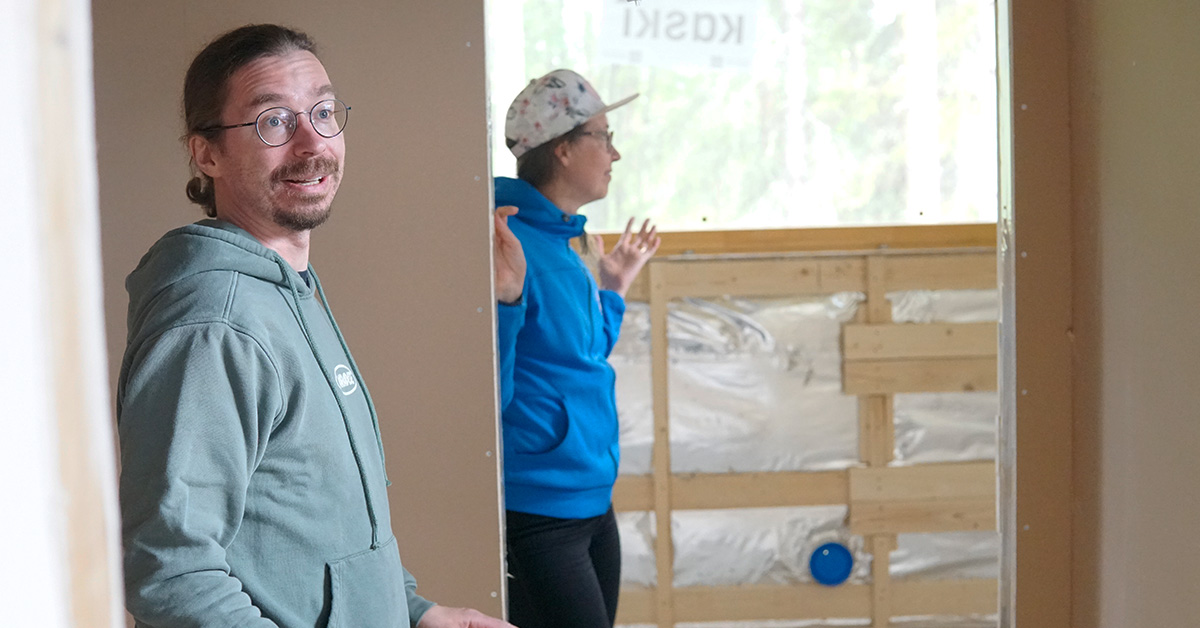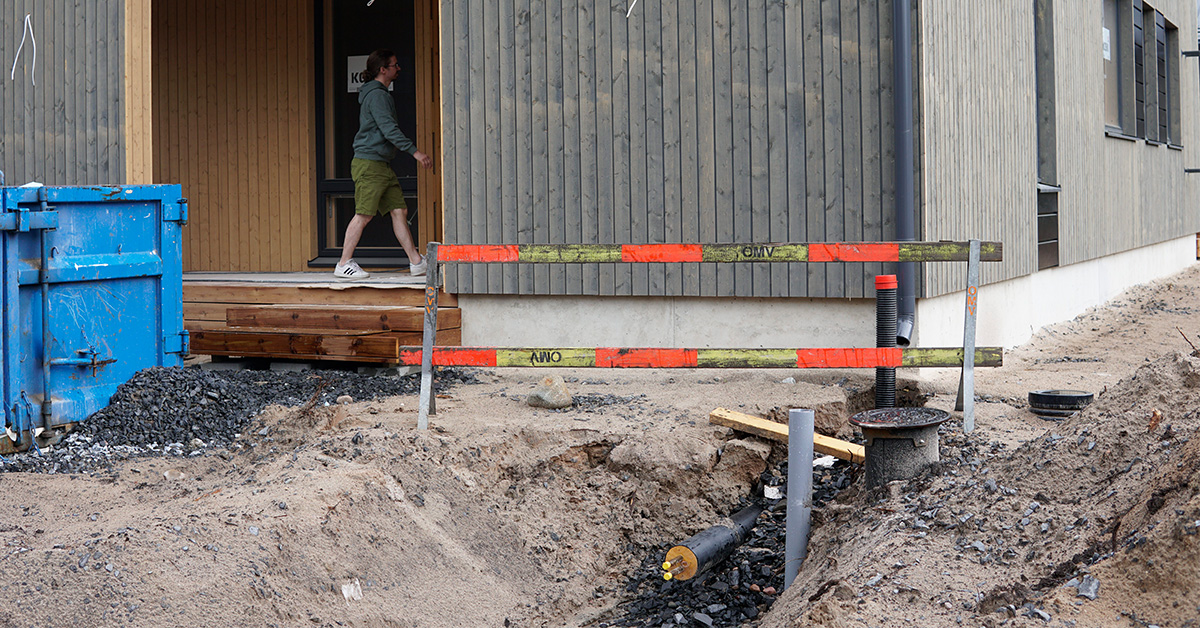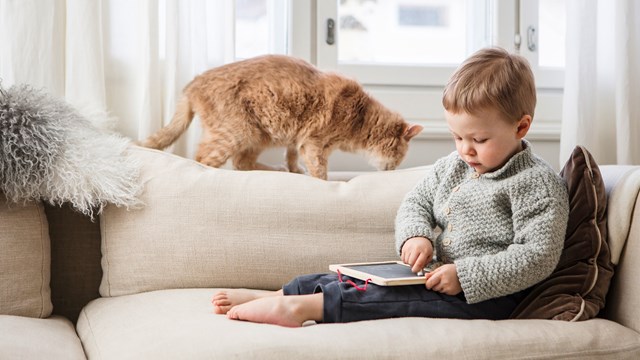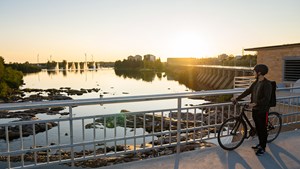District heating for the detached house—from design to finish
Kaisa Poikela and Jari Hannu are building their second house in Ritaharju. The two-story detached house, to be completed in September 2023, has been carefully designed based on the family’s previous experience. The construction and design process is a joint effort by the six-member family, and everyone has had a say in the outcome.
The family, who is moving from a stone’s throw away, has lived in their first home for over ten years. As the family grew and its needs changed, as remote work has become more common, for example, Kaisa and Jari realised their old home had become too small for them.
Kaisa and Jari took part in a drawing of rented lots organised by the city of Oulu twice, and luck didn’t favour them either time. The family finally got a new lot by taking part in a closed bidding, where the highest price of a lot is estimated. Kaisa and Jari prepared for the bidding like engineers:
“We made an Excel list in which we entered the previous years’ asking and offer prices for lots in the region. We calculated how much of an increase previously sold lots had experienced in percentage and in euros. The formula worked so well that we could even have gotten more than one lot out of the ones on offer.”
The stunning property bordering the forest is located in the new residential area of Ritaharju, right in the vicinity of neighbourhood services. The family acquired the lot in early spring 2022, and the process of designing the house started at the same time.
Kaisa and Jari wanted a unique home designed specifically for their needs, so it was clear they needed to include an architecture firm in the design process. In June 2022, they chose Saika design as their architecture firm.
“Tiina and Mikko from Saika visited the property once and we talked for a couple of hours. They were able to glean all the necessary information from the short meeting. The house is so close to being complete that we can state that the end result is exactly what we were hoping for.”
The design was started with the desire to build a functional but unique home for six people. There is a 140m2 main building and a 28m2 sauna building, which also has an office/living room, on the property.
Comparison of heating systems included ground source heating, heat pumps, and district heating
The family went to the Naantali Housing Fair the previous summer for ideas for housing and heating solutions.
“The Naantali Housing Fair properties used a lot of different heat pump solutions, which were pretty quickly dropped off our list because in Oulu’s latitude, winters are considerably colder, meaning that heating needs are different,” Kaisa and Jari note.
The detached sauna building, which is habitable year-round, posed another challenge to the operation of the heating system.
“We asked for tenders for ground source heating but we didn’t really even get a sensible offer on how to make the heating and hot water supply of the sauna building work cost-effectively,” Kaisa and Jari state.
The family also had long discussions with energy experts in their circle of family and friends. And they considered the choice of heating systems from many different angles. In the end, Kaisa and Jari chose district heating for their detached house. They get warm domestic water and underfloor heating in the sauna building without a separate hot water storage tank and the hot domestic water will not run out.

It was important for Jari and Kaisa that the sauna building is habitable year-round and that it shares the same heating system with the main building.
District heating was chosen for the detached house for its convenience and reliability
“We decided to choose district heating as the heating system for our home because we found it to be affordable and reliable over a long period of time,” Jari outlines.
In addition, Kaisa and Jari have more than 10 years of experience in district heating, as their current detached house is heated using district heat, and the family has never had any problems with it.
“The price/quality ratio has been good throughout our customer relationship. The upkeep of district heating has been effortless and there hasn’t been any need for any renovations to the equipment. In our situation, when there is a large family and a lot of water usage, warm water could quickly run out, but this has never happened while connected to district heating.”
It was also important for Kaisa and Jari that the heating system was as environmentally friendly as possible. The choice was influenced by the fact that customers can already acquire carbon-neutral district heating produced by Oulun Energia.
In the future, the company’s entire production will be carbon neutral. An example of carbon-neutral production is the capture of waste heat from refrigeration appliances at the family’s local S-market in Ritaharju (link in Finnish), where waste heat is harnessed into the district heating network by using a heat pump system. This waste heat can be used to heat nearly 200 detached houses for a year.
Drawings for district heating were made together with an HPAC design engineer
Kaisa and Jari found their HPAC design engineer well in advance, as the construction permit is conditional on approved HPAC drawings. The HPAC design engineer designed all the steps required for a heating system, such as the location of heating manifolds and how the pipework is laid.
“We had a meeting with the HPAC design engineer in September 2022 when we were still deciding between ground source heating and district heating. Then the price of electricity started to quickly increase and we noticed how much its rise affected the price of ground source heat. This was actually our last sign that we should choose district heating.”
When planning the location of the heating substation, the family wanted to ensure it wasn’t in the immediate vicinity of the bedrooms, as the equipment makes some noise. In addition, at the start of the house design process, it was decided that the utility room would be placed as close to the front door as possible, and that it would contain all the possible technology. This makes it easier to monitor the systems and to carry out any potential maintenance work.
 The connecting pipe is waiting to be connected to the district heating network at the front edge of the property.
The connecting pipe is waiting to be connected to the district heating network at the front edge of the property.
The district heating connecting pipe, from which district heat flows into the house, was installed on the edge of the house closest to the road. In terms of district heating, installing it on the front edge of the property is also the most cost-effective place, as additional metres of district heating piping from the edge of a property to the heating substation always cost extra.
They did not come by the solution by chance; they learned from their current house, where the utility room is located all the way in the back corner of the house.
“The old location has proved very impractical in use,” Kaisa laughs.
How to get district heating for a detached house
1. Choose a method of heating for your home
2. Request a quote
3. Purchase district heating
4. Provide us your heating plans
5. Order a connecting pipe
6. Purchase a heating substation
Why district heating?

Easy and reliable
District heating is a safe and reliable heating method for the customer. Security of supply is as high as 99.98%. District heating equipment is long-lasting and easy to maintain.

A stable price
Oulun Energia's district heating production is largely based on the use of renewable energy sources and the utilisation of waste heat, which keeps the consumer price moderate.

Environmentally responsible
District heating is produced sustainably and efficiently in Oulun Energia’s power plants from the region’s own raw materials. Centralised heat production significantly reduces local emissions and increases residential satisfaction.



